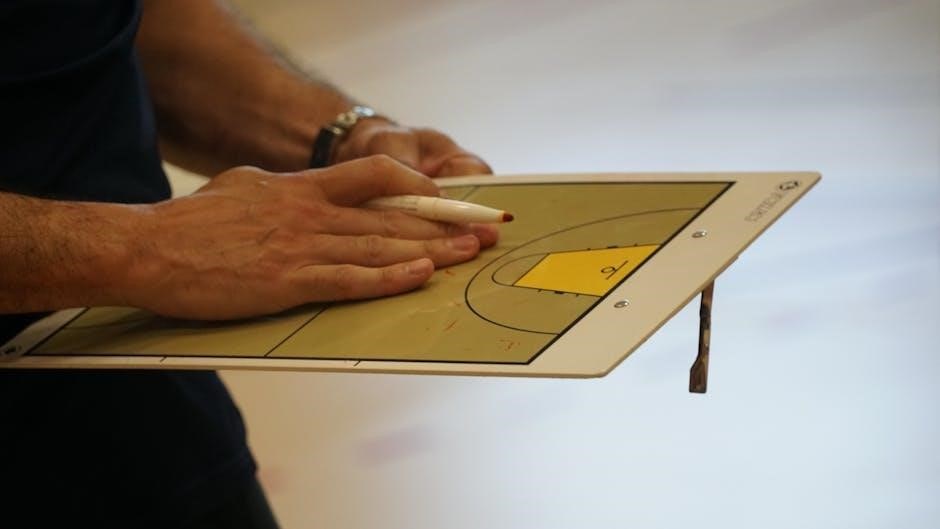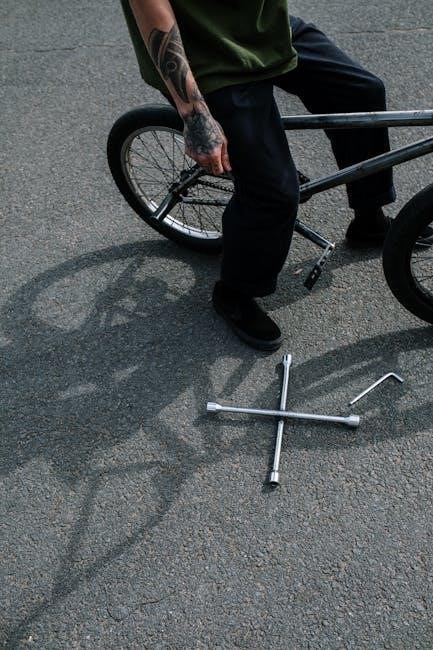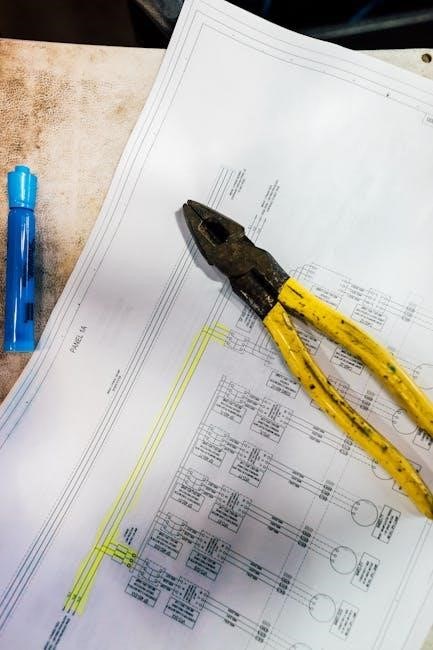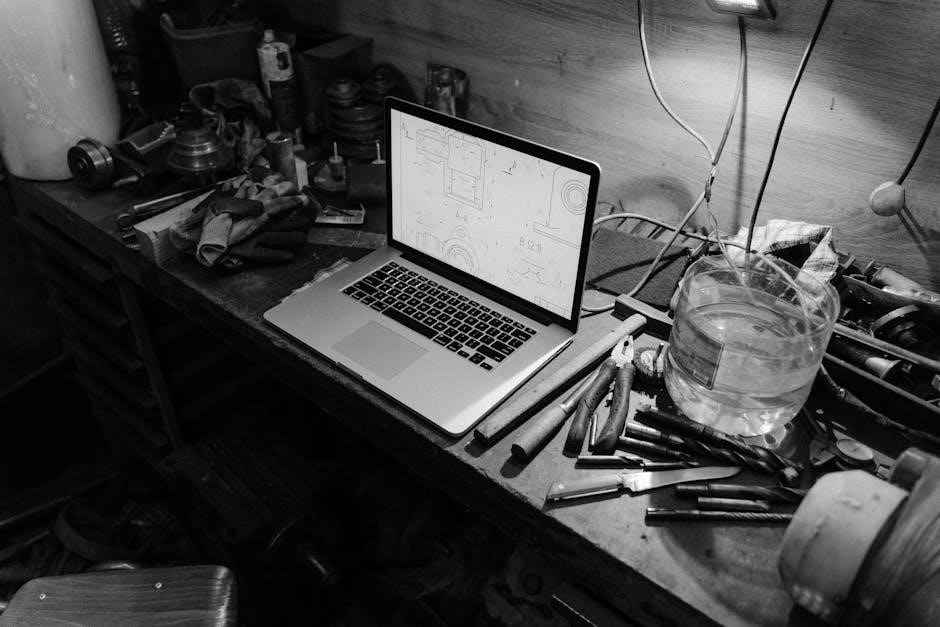The Harley rear wheel assembly is a critical component, comprising the wheel, bearings, spokes, and brake disc․ Proper installation requires a detailed service manual and exploded diagrams to ensure accuracy and safety․ Always use genuine Harley-Davidson parts for optimal performance and longevity․
Importance of Proper Assembly
Proper assembly of the Harley rear wheel is crucial for safety, performance, and durability․ Incorrect installation can lead to wobbling, brake failure, or other hazards․ Ensuring all components like bearings, spokes, and the brake disc are securely fitted guarantees smooth operation․ Using genuine Harley-Davidson parts and following the service manual precisely prevents premature wear and potential accidents․ Proper torque specifications and alignment are vital to maintain the integrity of the wheel and surrounding systems․ Neglecting these steps can void warranties and compromise the motorcycle’s reliability․ Always prioritize precise assembly to ensure optimal functionality and rider safety․
Overview of Components
The Harley rear wheel assembly consists of several key components essential for its function․ The wheel itself includes the rim, spokes, and hub, which house the bearings․ The brake disc is mounted on the hub, while the sprocket attaches to the hub for chain drive systems․ The axle and axle nut secure the wheel to the motorcycle frame․ Other components like spacers and seals ensure proper alignment and prevent contamination․ Each part plays a vital role in the overall performance, safety, and durability of the rear wheel․ Proper installation and alignment of these components are crucial for optimal functionality and rider safety․

Tools and Equipment Needed
Essential tools include a torque wrench, impact gun, and socket set․ Specialized tools like bearing pullers and spoke wrenches are also required for proper assembly and alignment․
Essential Tools for Assembly
The assembly requires basic tools like wrenches, screwdrivers, and pliers․ A torque wrench is crucial for securing bolts to the correct specification․ An impact gun speeds up loosening tight components․ Socket sets, including metric and SAE sizes, are indispensable for various bolts․ Tire levers are needed for removing and installing tires․ Ensure all tools are in good condition to avoid rounding bolts or damaging parts․ Additionally, a wheel chock or stand may be necessary for stabilizing the wheel during assembly․ Always refer to the service manual for specific tool recommendations to ensure a safe and accurate assembly process․
Specialized Tools Required
Besides basic tools, specialized equipment is necessary for the rear wheel assembly․ A bearing press is essential for installing and removing wheel bearings without causing damage․ A spoke wrench is required to tighten and adjust the spokes evenly, ensuring proper wheel tension․ For brake components, a brake bleeding kit may be needed to remove air from the brake system․ A dial indicator is useful for checking wheel alignment and ensuring the axle is properly seated․ Additionally, a hub nut socket is often required to secure the axle nut correctly․ These tools ensure precise and safe assembly, preventing potential issues like wobbling or brake failure․ Always use tools recommended by Harley-Davidson for reliability․

Understanding the Rear Wheel Diagram
The rear wheel diagram provides a detailed visual breakdown of components, including the hub, spokes, rim, and bearings․ It aids in identifying parts and their relationships, ensuring accurate assembly and repair by following the service manual instructions․
Exploded Diagram of Rear Wheel
An exploded diagram of the rear wheel is essential for understanding its assembly․ It visually separates components like the hub, spokes, rim, bearings, and sprocket․ This detailed illustration helps identify each part’s location and connections, making disassembly and reassembly easier․ The diagram is typically found in the service manual and includes numbered parts for reference․ By following the exploded view, technicians can ensure all components are correctly positioned and secured․ This visual guide is crucial for maintaining the structural integrity and proper function of the rear wheel, ensuring safety and performance on the road․
Parts Identification
Identifying each component of the rear wheel assembly is crucial for proper installation and maintenance․ The main parts include the hub, bearings, sprocket, brake disc, spokes, rim, and axle nut; The hub serves as the central mounting point, while the bearings ensure smooth rotation․ The sprocket engages with the chain, transferring power, and the brake disc provides stopping power․ Spokes connect the hub to the rim, maintaining structural integrity․ The axle nut secures the wheel to the bike․ Referencing the parts manual or service guide ensures accurate identification․ Proper identification is essential for ordering replacement parts and ensuring correct assembly, preventing potential safety hazards and performance issues․

Safety Precautions
Always wear protective gear and ensure the motorcycle is on a stable stand․ Use genuine Harley-Davidson parts and follow the service manual instructions precisely․ Proper torque specifications must be followed to avoid component failure․ Ensure all nuts and bolts are securely tightened to prevent loosening during operation․ Improper assembly can lead to safety hazards and potential accidents․ Refer to the exploded diagram for correct part placement and assembly sequence․ Adhere to all safety guidelines to ensure a safe and successful rear wheel assembly process․
Specific Safety Measures for Rear Wheel Assembly
When working on the Harley rear wheel assembly, ensure the motorcycle is securely supported on a sturdy stand to prevent accidental tipping․ Always wear protective gloves and eyewear․ Use only genuine Harley-Davidson parts to maintain safety and performance․ Refer to the exploded diagram in the service manual for correct part identification and assembly sequence․ Tighten all bolts and nuts to the specified torque values to avoid loosening during operation․ Never improvise with tools or components, as this can lead to critical failures․ Ensure the brake system is properly aligned and functional before test riding․ Follow all safety guidelines outlined in the manual to ensure a secure and reliable assembly process․

Disassembling the Old Rear Wheel
Begin by loosening the axle nut and removing the wheel․ Detach the brake disc and sprocket, ensuring all parts are securely supported․ Refer to the service manual for precise disassembly steps and safety precautions․ Mark components for proper reinstallation to avoid confusion․ Retain reusable parts like spacers and bearings for the new assembly․ Always follow the diagram and instructions to ensure a smooth process and maintain the integrity of the motorcycle’s components․ Safety is paramount, so use appropriate tools and techniques to prevent damage or injury․
Step-by-Step Disassembly Process
Start by loosening the axle nut using a torque wrench․ Remove the wheel from the axle, ensuring it is securely supported․ Detach the brake disc by removing the mounting screws, taking care not to damage the rotor․ Next, remove the sprocket by taking out the retaining bolts․ Mark all components for proper reinstallation․ Carefully pull the hub assembly apart, ensuring bearings and spacers are retained․ Document each step to avoid confusion․ Use a service manual or exploded diagram for guidance․ Ensure all parts are clean and stored safely․ This systematic approach prevents damage and ensures a smooth reassembly process․ Safety is critical during disassembly․
Identifying Reusable Parts
During disassembly, identify reusable parts such as the axle nut, wheel spacers, and bearings․ Inspect these components for damage or wear․ If they are in good condition, they can be reused during reassembly․ Ensure all reusable parts are cleaned and stored safely to prevent damage․ Refer to the exploded diagram in the service manual to locate and verify reusable components․ Proper identification ensures no essential parts are overlooked, which is crucial for a successful assembly․ Always prioritize genuine Harley-Davidson parts for compatibility and reliability․ This step is vital to maintaining the integrity and performance of the rear wheel assembly․

Preparing for New Rear Wheel Installation
Before installing the new rear wheel, ensure all components are inspected and cleaned․ Align the brake disc and sprocket precisely for proper function and safety․
Inspecting the New Wheel Assembly
Inspect the new rear wheel assembly for any damage or defects․ Check the bearings, spokes, and rim for proper alignment and integrity․ Ensure the brake disc and sprocket are securely attached and free from damage․ Verify that all components match the parts list from the service manual․ Lubricate the bearings according to the manufacturer’s instructions․ Ensure the wheel spins freely without wobbling or noise․ Refer to the exploded diagram for a clear view of the assembly․ Make sure all hardware, such as axle nuts and spacers, is included and undamaged․ Proper inspection ensures a safe and reliable installation․
Aligning the Brake Disc and Sprocket
Proper alignment of the brake disc and sprocket is crucial for smooth operation․ Place the wheel assembly on a flat surface and ensure the sprocket and brake disc are parallel to the axle․ Use shims or spacers as specified in the service manual to achieve accurate alignment․ Tighten the sprocket and disc mounting bolts evenly to avoid warping․ Refer to the exploded diagram for correct positioning․ Double-check the alignment by spinning the wheel and ensuring the brake disc does not wobble․ Misalignment can lead to poor braking performance or uneven wear on components․ Use a torque wrench to secure all hardware to the recommended specifications for optimal safety and functionality․

Installing the Rear Wheel Assembly
Slide the rear wheel assembly onto the axle, ensuring proper alignment․ Secure the axle nut tightly, following the torque specifications from the service manual․
Mounting the Wheel on the Axle
Begin by removing the old rear wheel assembly and retaining necessary components like the axle, axle nut, and spacers․ Clean and inspect the axle for damage or wear․ Align the new rear wheel with the axle, ensuring the brake disc and sprocket are properly positioned․ Slide the wheel onto the axle, making sure it seats securely․ Refer to the exploded diagram in the service manual for precise alignment․ Tighten the axle nut by hand initially, then use a torque wrench to secure it to the specified torque value․ Ensure the wheel spins freely and check the brake disc alignment before proceeding․
Securing the Axle Nut
After properly aligning and mounting the rear wheel on the axle, focus on securing the axle nut․ Begin by ensuring the axle is clean and free from debris․ Use a torque wrench set to the specified torque value, typically 100 ft-lbs for Harley rear wheels․ Place the wrench on the axle nut and apply steady, consistent pressure to tighten it․ Avoid jerking or forcing the wrench, as this could damage the axle or strip the threads․ Once the torque wrench clicks, indicating the set torque is reached, the axle nut is securely tightened․ Double-check the torque by applying another firm pull on the wrench․ Ensure the wheel spins freely and check for any misalignment or wobbling․ Take a short test ride to confirm stability and safety․ Always refer to the exploded diagram in the service manual for precise component placement and alignment․
Tightening the Spokes
Tightening the spokes is a crucial step to ensure proper wheel stability and safety․ Using a spoke wrench, begin by tightening each spoke in a star pattern to maintain even tension․ Start with the spokes on one side of the wheel, then alternate to the opposite side, gradually increasing the tension․ Refer to the torque specifications in the service manual to ensure the correct tension is applied․ After tightening, spin the wheel to check for wobbling or unevenness․ If any spokes feel loose or over-tightened, adjust them accordingly․ Properly tightened spokes will prevent vibration and ensure a smooth ride․ Always test the wheel by plucking the spokes to check for consistent tension before finalizing the assembly․

Post-Installation Checks
Verify wheel alignment, test brake functionality, and ensure all components are securely fastened․ Check for any wobbling or unusual noises during a test ride․
Verifying Wheel Alignment
After installing the rear wheel, ensure proper alignment by checking the wheel’s position relative to the swingarm and fender․ Use a torque wrench to confirm axle nut tightness․ Inspect the brake disc alignment with the caliper and test for any wobbling during a slow test ride․ Refer to the service manual for specific torque specifications and alignment procedures․ Proper alignment ensures smooth operation, prevents uneven tire wear, and maintains safety․ If misalignment is detected, adjust the axle position and recheck․ Always use genuine Harley-Davidson parts for optimal performance and reliability․
Testing Brake Functionality
After installing the rear wheel, test the brake system to ensure proper functionality․ Inspect the brake pads and disc for any signs of wear or damage․ Apply the brake lever several times to check for a firm, responsive feel․ Ensure the brake fluid level is within the recommended range and inspect for any leaks in the brake lines or caliper․ Test the brakes at low speed to confirm they engage smoothly and evenly․ If any issues arise, refer to the service manual for troubleshooting steps․ Proper brake function is critical for safety, so always use genuine Harley-Davidson parts and follow manual instructions carefully․

Troubleshooting Common Issues
Identify symptoms like wobbling or misalignment․ Check for loose spokes or worn bearings․ Consult the service manual for precise diagnostic steps and repair solutions․
Addressing Wobbling or Misalignment
Wobbling or misalignment in the rear wheel can lead to unsafe riding conditions․ To address this, loosen the axle nut slightly and adjust the wheel position to ensure proper alignment with the swingarm․ Tighten the axle nut to the specified torque once aligned․ Inspect the spokes for even tension and tighten any loose ones․ If the rim is bent or damaged, replace it immediately․ Always refer to the service manual for precise alignment and torque specifications․ Proper adjustment ensures stability and safety while riding․
Fixing Loose Spokes or Bearings
Loose spokes or bearings can cause instability and premature wear․ Tighten loose spokes evenly by turning the nipple clockwise with a spoke wrench․ Check the wheel for trueness after tightening․ For bearings, remove any debris and apply a thin layer of Harley-Davidson-approved grease․ Reassemble the hub and ensure the bearings are securely seated․ If bearings show signs of wear, replace them with genuine Harley-Davidson parts․ Properly tightened spokes and lubricated bearings enhance safety and performance, ensuring a smooth ride․ Always follow the torque specifications outlined in the service manual for optimal results․

Maintenance and Care
Regularly clean the rear wheel and spokes to prevent rust․ Inspect for wear and tear on the rim and hub․ Lubricate moving parts as needed․ Ensure all bolts and nuts are tightened to the manufacturer’s specifications․ Refer to the service manual for detailed maintenance schedules and torque values to maintain optimal performance and safety․
Regular Lubrication of Bearings
Proper lubrication of the rear wheel bearings is essential for smooth operation and longevity․ Begin by removing the wheel and accessing the bearings, following the service manual’s instructions․ Use a high-quality, heat-resistant grease suitable for motorcycle bearings․ Apply the lubricant using a grease gun or syringe, ensuring the bearings are adequately coated without overfilling․ Clean old grease and debris beforehand for optimal results․ Reassemble the wheel and tighten the axle nut to the specified torque value to prevent damage or unsafe conditions․ Regular lubrication, ideally every few thousand miles, helps prevent bearing failure and ensures safe riding․ Always refer to the manufacturer’s guidelines for precise instructions and torque specifications․
Inspecting Spokes and Rim
Regular inspection of the spokes and rim is crucial for maintaining the structural integrity of the rear wheel assembly․ Start by visually examining the spokes for signs of damage, rust, or loosening․ Ensure all spokes are evenly tensioned, as uneven tension can lead to wheel misalignment or failure․ Check the rim for dents, cracks, or excessive wear, which could compromise tire sealing and safety․ Use a spoke wrench to tighten any loose spokes, following the torque specifications in the service manual․ Inspect the spoke nipples and hub for corrosion or debris, cleaning as needed․ Proper maintenance ensures optimal performance, safety, and longevity of the rear wheel․ Regular checks are essential before long rides or as part of routine motorcycle maintenance․
Proper assembly and maintenance of the Harley rear wheel ensure safety, performance, and longevity․ Always follow manual instructions for accurate installation and regular checks․
Final Checks and Test Ride
After installing the rear wheel assembly, perform a final inspection to ensure all components are securely fastened․ Check the axle nut torque, spoke tension, and brake functionality․ Consult the service manual for specific torque values and alignment guidelines․ Take the motorcycle for a test ride on a flat, open surface to verify proper operation․ Listen for unusual noises or vibrations, which may indicate misalignment or loose parts․ If issues arise, return to the workshop for adjustments․ Always document the process and schedule regular maintenance to maintain optimal performance and safety․ Following these steps ensures a smooth, reliable ride and prevents potential hazards․
Importance of Following Manual Instructions
Adhering to the service manual ensures a safe and successful rear wheel assembly process․ Using genuine Harley-Davidson parts and following torque specifications prevents damage and maintains warranty validity․ The manual provides detailed exploded diagrams and step-by-step guides, minimizing errors and ensuring all components are properly aligned․ Skipping steps or using unauthorized parts can lead to safety hazards, such as wheel failure or brake malfunction․ Proper installation guarantees optimal performance, reliability, and rider safety․ Always refer to the official manual for accurate information and procedures, as deviations may result in mechanical issues․ Compliance with manual guidelines is crucial for achieving a professional-level assembly and avoiding costly repairs․





